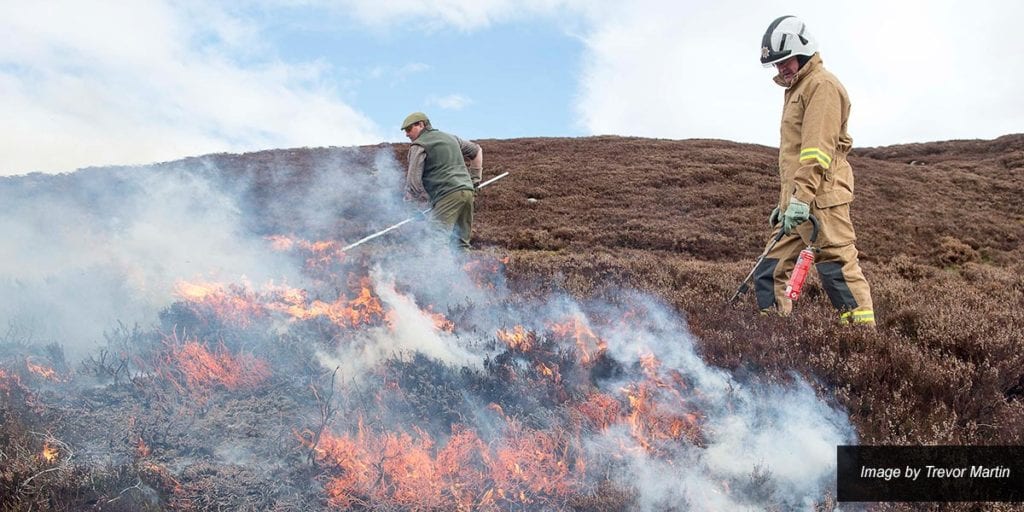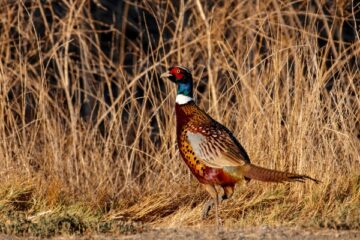Moorland
A closer look at moorland habitat, its management and benefits for the natural environment and rural communities, by Gareth Dockerty.
What is a moorland habitat?
Moorland is generally a type of open habitat found in upland areas and located on acidic soils. The main characteristic that links moorland across the UK and further afield is some form of low-growing vegetation that is not cultivated.
Drive through a moor in the Brecon Beacons, Peak District, Northumberland, N.Ireland, Lancashire, North Yorkshire or the Scottish Highlands and you may think that these open landscapes of green, brown and purple are the same. However, on closer inspection a variety of habitats and species are present.
What habitats will you find on a moor?
Most moorlands feature some form of heath (with species like heather or bilberry), along with blanket bog on deeper peat, grassland, and woodland. Our wild and native red grouse have evolved to need heather moorland, thus the link between grouse shooting and many moors.
It is thought that we have 75 per cent of the world’s heather moorland in the UK, and this type of habitat is incredibly rare within a global context. Grouse moors have helped conserve and manage this habitat for well over a century, but just how valuable are they for wildlife other than grouse?
The simple answer is that they are very valuable; grouse moors make up 79 per cent of all upland Special Protection Areas, and 90 per cent of all grouse moors in England fall within AONBs or National Parks. These sites were designated on active grouse moors that had been previously managing the land for at least 50 years – the quality of the landscape and diversity of wildlife was, and is, due to grouse moor management.
The management of grouse moors
Habitat management and predator control are the key tools for the upland grouse keeper to ensure grouse can breed and reach a population level that allows a surplus to be sustainably shot.
Heather moorland is a transition habitat along the succession cycle. The easiest way to explain this would be to think of what would happen if you were to dig a pond in the uplands and wait a few hundred years. The pond will begin its successional journey towards mature woodland; heather moorland occurs along this journey.
Thousands of years ago, small pockets of moorland would have existed where native animals had grazed areas, or floods and fire had removed the trees. To keep a moorland at this stage of succession, we need to implement some forms of management.
We can safely say that the managed heather moorlands are visited by millions of people each year. Today, the term ‘managed’ often comes with negative connotations, but let’s remember the much-valued traditional hay meadow is a completely managed habitat, too. On a small island with over 66 million people, managing landscapes for multiple benefits is essential.
Habitat management
Providing a habitat for multiple uses including grouse shooting is more of an art than a science and involves reading the landscape and factors impacting a moor. Contrary to anti-grouse shooting propaganda, grouse moors do not need a single-level carpet of heather. In fact, the key objective is to provide a mosaic of vegetation heights and species.
Grouse chicks feed on insects, so wetter areas of sphagnum mosses benefit the insect diversity and overall population. Grouse keepers also have a duty to ensure their management creates net benefits for other species and local communities. With such a high proportion of moors on protected sites, there must be a balance between grouse shooting and broader conservation needs.
Burning

Excuse the pun but this really is the ‘burning issue’ of the past few years. Gamekeepers have used burning as a management tool to reduce the vegetation on moors for generations, and there are countless examples – going back hundreds (if not thousands) of years – of communities around the world that use controlled burns to stimulate new growth and protect landscapes from devastating wildfires.
Controlled burning is a precise and professional operation – it is much more than a box of matches and some dry weather. It involves excellent planning, teamwork and often specialist kit. Keepers must understand and comply with strict burning codes (and consents on protected sites), with the burning season running from October to April.
The rank vegetation is burnt off when the peat below is holding water and before the bird nesting season. Controlled or ‘cool’ burns do not burn the peat or understorey of sphagnum mosses.
BASC believes that burning should remain part of the overall toolkit available to land managers. However, the current policy of Natural England and Natural Resources Wales is to ban burning on blanket bog habitats (areas of peat deeper than 40cm), and there is a clear divide in views about burning within the scientific community.
The latest scientific research via York University demonstrates that, under the right conditions, burning can still be a vital management tool for our moors.
For more information on burning, read our blog The Burning Issue here.
Mowing
As the restrictions on burning increase, mowing is often seen as the alternative. However, mowing is not a direct replacement for controlled burns. All forms of management have different pros and cons; the key is to use the most appropriate tools at each location. In principle, mowing a flat and well-drained field is simple; however, mowing sections of moorland with steep slopes, bogs and sensitive habitats is a complex operation. It is impossible to mow some sections of a moor.
Mowing is also a more expensive form of management. And then there is the issue of what to do with the cut material – is it collected? Where is it stored? This is expensive and time-consuming. Or do you just leave the brash? This could create a wildfire risk later in the year. It could also increase the methane output of the moor, and contribute to climate change as the vegetation rots.
Grazing
Grazing animals, such as sheep, cattle and ponies, are an essential part of moorland management and help by reducing rank vegetation. Sheep are selective grazers – they know what they like and tend to look for it. If you over-graze a moor, not only will you lose the varied height of vegetation, but you will also reduce the species diversity. High densities of livestock can also cause poaching and leave large bare patches of peat which are vulnerable to erosion and carbon loss.
A good relationship between the farmer and keeper is essential so they can work together rather than against each other. Once a grazing system is lost, it can be incredibly difficult to set up from scratch. Indeed, the uplands can be a harsh environment and stock need to be hardy with knowledge of the moor – they often need to be ‘hefted’ an area (accustomed to it through herding until they do not wish to stray).
Sheep can also provide a ‘tick-mop’ service. Tick burden can be a real issue for ground-nesting birds and chicks can be vulnerable. There is evidence to suggest a well-managed sheep flock treated for ticks can reduce the tick population on a moor, thus protecting other species.
For more information on ticks and Lyme disease, click here to read our blog.
Predator control
We are all aware of the need for balance and the impact predators can have on species populations. The science is very clear that predator control does benefit ground-nesting birds. Mobile, adaptable, and intelligent predators like corvids, foxes and stoats can devastate already vulnerable and declining species like the curlew.
The control of predators is a key task of a grouse moor keeper, that requires a meticulous and dedicated approach and keepers must be up to date with any changes in legislation or their consents.
The recent attempts by Wild Justice to challenge the general licences has, without doubt, impacted on ground-nesting birds in the uplands. Moving forward, our focus will be on collating data, monitoring, supporting keepers with evidence gathering, and providing case studies of predator impacts.
Rewetting
The habitats we have today are a product of our past actions. Moorland is no exception. The government grants to dig drainage grips (ditches) from the 1950s to ‘improve’ moorland for agricultural land are long gone. However, the keepers who generations ago helped dig these grips are now a key partner in blocking them up to ‘re-wet’ sections of moorland once again.
A passion, not an obsession
A well-managed grouse moor can provide a landscape the general public want to visit. The same people spend money with local businesses. Grouse shooting creates direct and indirect employment opportunities, benefits wildlife and contributes to the fight against climate change. Grouse moors can also help protect communities from floods. All of these benefits come at a far lower cost to the taxpayer than any other proposal for our moors. It can be a win-win situation for all.
However, when grouse shooting turns into an obsession, there is a risk of negative impacts. The illegal persecution of raptors is a concern; there is no excuse to break the law to benefit shooting prospects. Along with other shooting organisations who signed the zero tolerance statement, BASC has been clear about the need to tackle raptor persecution. We continue to work with partner organisations and we are involved with national and local raptor groups to address the situation. Read the joint statement issued in January 2020 by shooting organisations condemning all forms of raptor persecution here.
There is a growing pressure on grouse shooting, and keepers are regularly watched and disrupted by anti-shooting groups. Legal traps are damaged and there have been suspicious cases of traps being planted to suggest illegal activity. Keepers must follow the guidelines and law (no matter how bureaucratic this may seem at times) and ensure the shooting community has a credible platform from which to defend and protect our sport and its many benefits. Although a very small minority of people undertake illegal acts, each case damages the reputation of all forms of shooting.




